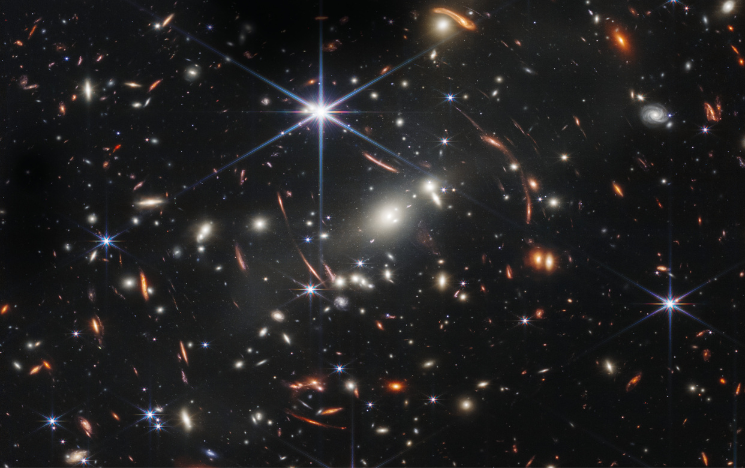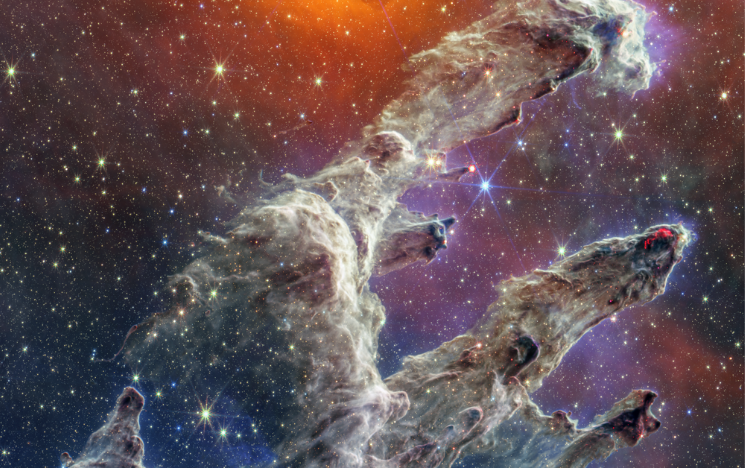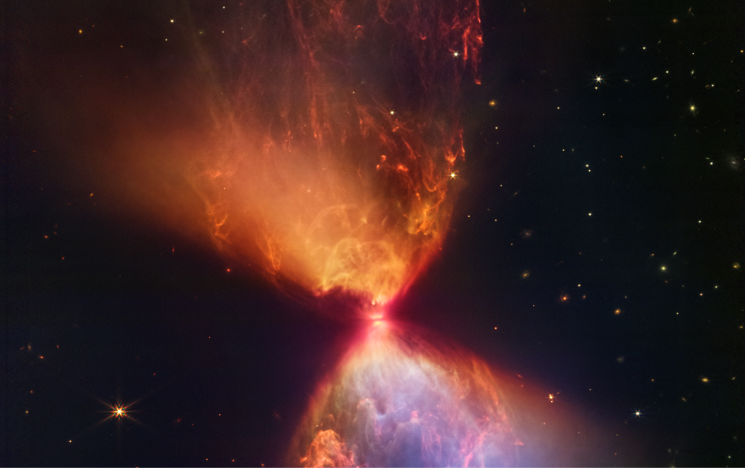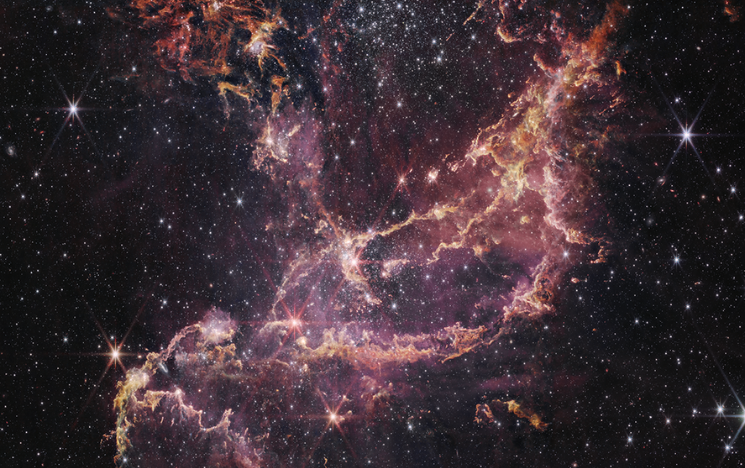 Webb's First Deep Field Unveiled (NIRCam Image). JWST's first deep field, a view of the galaxy cluster SMACS 0723. Many of the objects in the image lie behind this relatively nearby collection of galaxies, including some of the most distant galaxies in the Universe.
Webb's First Deep Field Unveiled (NIRCam Image). JWST's first deep field, a view of the galaxy cluster SMACS 0723. Many of the objects in the image lie behind this relatively nearby collection of galaxies, including some of the most distant galaxies in the Universe.
First light
After more than 30 years of development, the James Webb Space Telescope launched on Christmas Day 2021. The astonishingly sharp pictures captured by the telescope reveal previously invisible areas of star birth, shattering astronomers’ preconceptions about the early Universe.
The James Webb Space Telescope (JWST) is humanity’s newest flagship astronomical observatory. It is a collaboration between NASA, the European Space Agency (ESA) and the Canadian Space Agency (CSA), with significant UK involvement in its development and use. It was designed to answer a wide range of outstanding questions in astrophysics, including what is the composition of planets around other stars – so-called exoplanets – and do any harbour life? How were the elements vital for life on Earth created? And how did the first stars and galaxies form and evolve?
 Pillars of Creation (NIRCam and MIRI Composite Image). JWST's view of the Pillars of Creation, a region of the relatively nearby Eagle nebula. Inside these immense clouds of gas and dust new stars are forming.
Pillars of Creation (NIRCam and MIRI Composite Image). JWST's view of the Pillars of Creation, a region of the relatively nearby Eagle nebula. Inside these immense clouds of gas and dust new stars are forming.
To answer these questions, JWST was designed with enhanced capabilities over its predecessors, such as the venerable Hubble Space Telescope, which turns 33 this year. These capabilities include a mirror that is almost six times larger than Hubble’s, which means not only can it collect more light enabling it to see fainter, more distant objects, it can also see objects in more detail. And unlike Hubble, JWST is designed to observe the Universe in the infrared – invisible light beyond the red end of the spectrum – which allows it to peer through dense clouds of gas and dust to the sites of star formation and push back into the early history of the Universe.
 L1527 and Protostar (NIRCam Image). JWST's view of a newly forming star, a protostar. Ejections from the star have cleared out cavities above and below it, whose boundaries glow orange and blue in this infrared view.
L1527 and Protostar (NIRCam Image). JWST's view of a newly forming star, a protostar. Ejections from the star have cleared out cavities above and below it, whose boundaries glow orange and blue in this infrared view.
This focus on the infrared motivates JWST’s two most striking design features: its gold-plated mirror (gold reflects infrared light far better than steel or aluminium) and its large sunshield, which keeps the telescope cool (warm objects emit infrared light). In addition, JWST was built with spectroscopy in mind; the ability to split light into individual colours or wavelengths. This is essential to measure the chemical composition of alien atmospheres and distant galaxies.
Following the Christmas Day launch in 2021, JWST spent the next month making its way to Earth’s second “Lagrange point” (L2), a special location in space five times further away from the Earth than the Moon. From this vantage point, the telescope is free from the glare of the Earth, Moon and Sun allowing it to see further and deeper than ever before.
Unlike Hubble, JWST is designed to observe the Universe in the infrared which allows it to peer through dense clouds of gas and dust to the sites of star formation.” Dr Stephen wilkins
Head of Astronomy
SUSSEX@60 First Light with the James Webb Space Telescope
- Video transcript
[Intro MUSIC: Fast paced indie rock]
[Video footage of University of Sussex campus in the 1960’s and 1970’s inside a 60 graphic cutout]
[TITLE CARD: 60 years of Sussex. First Light with the James Webb Space Telescope. Dr Stephen Wilkins, Reader in Astronomy, School of Mathematical and Physical Sciences. University of Sussex logo.]
Visiting Professor Claudia Hammond: A lot of you may have seen, a few weeks ago, the amazing pictures of Jupiter taken from the James Webb telescope.
And our next speaker is going to be talking to us about that. And you may have seen the pictures when the when the telescope was sent up and it was unfolding all its mirrors. Absolutely amazing pictures.
So, we're going to hear from Stephen Wilkins.
And Stephen is a Reader in physics and currently serves as the head of Astronomy.
And before Sussex, he was at Oxford and Cambridge universities and his research focuses on studying the first stars and galaxies to form in the universe.
He's going to talk to us now. And Stephen, I noticed that in your biog your interest in astrophysics was all sparked by a computer game from the nineties.
So, I'm dying to know what that was now. What was it?
[Speaking off camera] Dr Stephen Wilkins: That was a game called Frontier Elite. Some of you may remember it.
Claudia Hammond: There we are. Please welcome Stephen.
[Applause]
Stephen Wilkins: Thank you very much, Claudia. It's great to see so many people here today.
I hope you’re having a really good weekend back here.
I've been in awe for the last month or so because we've been waiting nearly 30 years for this new space telescope.
And we finally had it launched.
This is it.
[Screen shows photo of the James Webb Space Telescope inside a building, with NASA, ESA and CSA ASC logos overlaid]
And hopefully you can see the connection with the previous talk here.
[LAUGHTER]
So we can see the honeycomb pattern because, you know, although mine and Beth’s work
is completely literally worlds apart, everything’s connected.
So what I'm going to talk about today is some of the very first results from this amazing new facility that we've got. This is the James Webb Space Telescope.
And hopefully over the last few months or over the last year, you've heard some of the information about this because it really is, you know, our most impressive scientific instrument ever created.
Now, some of my particle physicist colleagues might disagree with that. They've got their Large Hadron Collider but really, this is it. This is a telescope which is $10 billion.
This is not just, although you wouldn't believe this by looking at the media, a NASA program. In fact, this telescope, the James Webb Space Telescope, actually, like its predecessor of the Hubble Space Telescope, is a huge collaboration between NASA, the European Space Agency, so us and also the Canadian Space Agency.
It also includes thousands of astronomers and scientists and engineers across the world.
There are tens of thousands of people who are going to use this facility over the next 10 or 20 or even 30 years.
This really is what's going to shape our understanding of the universe over this period of time.
But just to point out, there's actually really, really strong UK contribution over here, and this is actually the least impressive image I'm going to show you.
[VIEW FROM REAR OF LECTURE THEATRE SHOWING IMAGE OF JWST CAMERA ON SCREEN BEHIND DR STEPHEN WILKINS]
This is a camera and one of the cameras, actually, this is four cameras, one of these cameras over here was built here in the UK.
So actually the most advanced camera, of course, we would say that, on this telescope was built here in the UK. Mostly built up in Edinburgh, but then lots of the testing down in Leicester.
And then we've been using it recently to learn about the universe.
[FULL SCREEN IMAGE SHOWS ROCKET LAUNCHING JWST WITH ESA LOGO AND THE WORD ‘ARIANE’ VISIBLE ON HOLDING STAND]
The other great thing that the European Space Agency did - so our contribution or your contribution, so this is your tax money that's gone into this - is that we actually launched
the telescope into space.
[VIEW FROM REAR OF LECTURE THEATRE SHOWING IMAGE OF JWST LAUNCH ON SCREEN BEHIND STEPHEN WILKINS]
So here we have an Ariane Five rocket. This is Europe's largest launcher. You can see hopefully the nice big ESA logo there.
And if you squint really really carefully at the top of the rocket there, you can actually see the James Webb Space Telescope logo as well.
So this rocket here is actually launching James Webb. And this was a really, really special
launch because this is a launch that had been delayed for maybe 10 years, right after a development of around 20 years.
And this telescope finally launched. But it launched on a very special day because it launched on Christmas Day in 2021.
[FULL SCREEN IMAGE SHOWS ROCKET LAUNCHING JWST WITH ESA LOGO AND THE WORD ‘ARIANE’ VISIBLE ON HOLDING STAND – NOW WITH SANTA HAT GRAPHIC ADDED TO TOP OF ROCKET]
[LAUGHTER]
I was actually supposed to go to this launch when it was due to launch about five years ago.
But unfortunately, because of these delays that no longer happened and the way that I celebrated
this launch was actually peeling carrots in my parents-in-law's house in Leeds.
[LAUGHTER]
So I had a little iPad there and I was watching that, watching this momentous launch while peeling carrots.
And it was just such a weird thing at the same time. So after many, many years of delays, we finally got this telescope.
And since then, we've been testing the telescope.
It has to fly a long way,
So this telescope actually sits in space five times further away than the moon.
Okay, so this is a million and a half kilometres away.
And from that vantage point, it's able to take these amazing images of our universe.
I'm going to show you just a handful of these images now.
First of all, I’m going to start off as close as we really can and hopefully you can recognise this.
This is Jupiter.
[VIEW FROM REAR OF LECTURE THEATRE SHOWING IMAGE OF JUPITER ON SCREEN BEHIND STEPHEN WILKINS]
This is Jupiter, as viewed by the James Webb Space Telescope.
This doesn't really look particularly impressive considering that we've had probes around Jupiter,
been able to take, much more impressive images in the visible light that we can see with our own eyes.
But this is a completely new view of Jupiter because what James Webb is doing, which is different from Hubble, is actually viewing our universe in the infrared and that light that we can't see with our own eyes.
So what you see in this image, in fact, there’s a huge amount of interesting things in this image.
What you're seeing is the storms in Jupiter and the hotter the storm is, the brighter it appears.
So you can see, for example, the very bright circle down on the bottom right.
That's actually the great red spot. So this is one giant storm and that's a very different storm from the surrounding areas.
Other things you might be able to see is that there's a big black spot.
For those of you who are science fiction fans, this has got nothing to do with 2010 A Space Odyssey.
This is actually the shadow of one of Jupiter's moons.
And if you look really carefully on either side of the disk of Jupiter, you can see a faint ring, that's actually a ring.
So it isn't just Saturn that has a ring system. Jupiter has one as well.
And if you look carefully, you can see a few little smudges around, they’re individual moons.
So Jupiter is about the closest thing that the James Webb Space Telescope can look at it.
So what I'm going to do now is look further out into our universe and see what else we can see.
Well, this is probably the most boring image that I'm going to show you, but it's tremendously important.
[FULL SCREEN IMAGE OF GRAPH SHOWING POINTS MARKED INDICATING WATER IN THE ATMOSPHERE OF A PLANET]
One of the things that the James Webb Space Telescope was meant to do, was to not look at planets in our own solar system, planets that have been studied very well for a long time.
It's to look at planets around other stars. You could call these alien planets. That's exactly what they are. They're planets which don't belong to our star.
And what James Webb can do is not just look at those planets, not just find them. It can tell you what's in their atmospheres.
So in this planet over here, what these little wiggles - these dots are showing you is that, in the atmosphere of this planet, there's actually water.
Now, water is tremendously important. Really, really critical for the existence of life.
And one of the things that we hope to be able to do in this area of science with the James Webb Space Telescope is actually detect things like water, but also carbon dioxide, ozone and oxygen
in the atmospheres of other planets.
And so down the line, James Webb will have the capability of actually saying, whether a planet has life on it.
I can't guarantee you that it's going to discover life out there in the universe because we don't know.
But we finally have the capabilities to actually do that test.
So, I'm really hoping in the next five or 10 years, that is one of the most amazing things that we see.
That's kind of a civilization-changing discovery. If we're not alone in the universe.
Now, I'm not talking about little green men here. I'm talking about little green plants.
What we're going to see here is if we do this detect life, it's things like vegetation or the signs of vegetation.
Other things that James Webb can do is study where stars and planets came from in the first place.
[FULL SCREEN SHOWING ‘COSMIC CLIFFS IN THE CARINA NEBULA’]
This is by far my favourite image that James Webb has taken. This is a real image.
This is a real part of our own galaxy. And what you're actually seeing here is a region
of the galaxy which has lots of gas and dust.
And from this gas and dust, you form new generations of stars and planets.
Okay, so you can look at this image online. Go and download it from the ESA website or the NASA website and you can zoom in.
You can get much better detail than I’m showing you here.
But many of the little points of light that you're seeing here, these are new stars that have just been born, that might have new planetary systems around them.
[[VIEW FROM REAR OF LECTURE THEATRE SHOWING IMAGE OF THE REMNANT OF A STAR WHICH HAS DIED, ON SCREEN BEHIND STEPHEN WILKINS]
Stars don't just live, they die.
So some stars live a few million years.
Stars like the Sun will live a few billion years and other stars will live as long as the universe will live.
But stars like the Sun often end up like this. This is the remnant of a star which has died.
Now, that may seem really kind of depressing and sad, but this is actually crucial to our existence
here on Earth. Because when stars die, they release elements, that they've created during their lifetimes, into the wider universe.
So things like oxygen, nitrogen, iron, all of these elements which are vital for us and all life, were created in events like this a long time ago.
So when the universe first started, it was only really hydrogen and helium that was created.
Everything else was created in events like this and giant supernova explosions.
So stars dying is, you know, sad in a way, but it's really vital.
We wouldn't be here if progressive generations of stars hadn't lived and died before us.
Okay, we can go further.
We can look at entire collections of stars and gas and dust.
[FULL SCREEN SHOWING 3 CLUSTERS /BLOBS CONTAINING BILLIONS OF STARS]
These are a collection of very famous galaxies.
Each one of these blobs here contains hundreds of billions of stars and they're merging together in this system over here.
So what we're seeing here is, you know, billions of stars.
But what I work on is using telescopes like Webb and like Hubble before it, to actually explore the very earliest part of the universe's history.
And the way we can do this is by just looking out into the universe.
So when we look at the moon, we don't see the moon as it appears right now.
We see, as it appeared about a second and a half ago.
[VIEW FROM REAR OF LECTURE THEATRE WITH SCREEN SHOWING SMALL IMAGE OF THE MOON]
If we look at Jupiter, we see it as it actually appeared about 45 seconds, 45 minutes ago, sorry.
[VIEW FROM REAR OF LECTURE THEATRE WITH SCREEN SHOWING SMALL IMAGES OF THE MOON AND JUPITER]
And if we look at this star forming region, the Carina nebulae, we’re actually seeing as it was 8,000 years ago.
[VIEW FROM REAR OF LECTURE THEATRE WITH SCREEN SHOWING SMALL IMAGES OF THE MOON, JUPITER AND THE CARINA NEBULAE]
And this collection of galaxies, we're seeing it as it appeared 280 million years ago.
[VIEW FROM REAR OF LECTURE THEATRE WITH SCREEN SHOWING SMALL IMAGES OF THE MOON, JUPITER, THE CARINA NEBULAE AND A CLUSER OF GALAXIES]
Now if we look further and further away, we look further back into the universe's history.
And if I what myself my group do here at Sussex, is we take images like this.
[FULL SCREEN VIEW OF STARS AND GALAXIES IN THE DEEP FIELD]
This is one of our deepest views of the universe.
And we look at every single one of those little blobs of light and we work out how far away it is. And from this image and images like it, so things like the Hubble which are deep field, and which came before it we can explore back across almost the entire history of a universe all the way back to the Big Bang and the very first stars and galaxies to form.
And just to zoom in here in one of my new favourite galaxies we discovered.
[FULL SCREEN VIEW OF ‘SLUG’ GALAXY IN THE DEEP FIELD]
We have this 'slug' galaxy over here. This galaxy that we're actually able to see even further back
because its light has been magnified and distorted by this nearby galaxy.
And that's the end. With Webb, we've only really just scratched the surface.
We've had a month worth of data, and already it’s started to revolutionise our view of the universe.
Over the next 10,20 years, we hope to learn so much more about our universe.
But, you know, really crucially, create all these beautiful pictures that anybody can enjoy.
Thank you very much.
[APPLAUSE]
[END CARD. University of Sussex logo]
https://vimeo.com/760993430
After six months of commissioning, during which the telescope and instruments were turned on and tested, JWST released its first operational images. Such is the extraordinary nature of JWST that the first image was released by the President of the United States to international fanfare.
Since then, there has been a steady stream of new data received from JWST, such as relatively nearby areas of star formation, for example, the Pillars of Creation. It has observed objects ranging from Jupiter to newly forming stars – and even remnants of dead stars. However, most exciting are the views of otherwise blank patches of sky, the so-called Deep Fields. While these patches of sky appear empty to smaller telescopes, when observed by JWST they are found to contain thousands of faint objects which, as it turns out, are mostly galaxies – collections of stars, gas, dust, planets and dark matter – that stretch back over most of the Universe’s history.
We’re observing galaxies only
a few hundred million years after the big bang, some of which are likely forming stars for the first time.” Dr Stephen wilkins
Head of Astronomy
This remarkable ‘time travel’ footage is made possible because light travels through the Universe at a finite, yet swift, speed. This means the further away we look, the further back in time we see. For example, when we look at the Moon, we’re actually seeing it as it appeared just over a second ago. The Deep Fields contain objects that stretch back over almost the entire history of the Universe, and it’s the most distant objects that we’re most interested in. We’re observing galaxies only a few hundred million years after the big bang, some of which are likely forming stars for the first time.
JWST is less than six months into what could be a 20-year mission or more. Already, it has provided amazing new insights into our Universe and begun to answer many of our outstanding questions. That said, perhaps the most exciting prospect is if JWST discovers something entirely unexpected that could shine further light on the fundamental nature of the Universe and where we all came from. Hopefully, time will tell.
 Star Formation in NGC 346 (NIRCam Image). JWST's view of NGC 346, a star forming region in the Small Magellanic Cloud, a nearby galaxy observed by eye from the Southern Hemisphere. The image shows clouds of gas illuminated by hot, young stars.
Star Formation in NGC 346 (NIRCam Image). JWST's view of NGC 346, a star forming region in the Small Magellanic Cloud, a nearby galaxy observed by eye from the Southern Hemisphere. The image shows clouds of gas illuminated by hot, young stars.
Dr Stephen Wilkins is Head of Astronomy and Director of Outreach and Public Engagement in the School of Mathematical and Physical Sciences.
The University would like to thank and credit NASA for the use of photographs in this article.